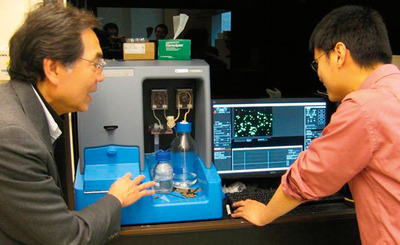Characterising ‘nanoconstructs’ for biomedical applications
Tuesday, 22 May, 2012
At Duke University, Professor Tuan Vo-Dinh and his research group have been characterising metal nanoparticle construct materials for use in biosensing, imaging and cancer therapy. This has been made possible through nanoparticle charcterisation technology manufacturer NanoSight and the company’s Nanoparticle Tracking Analysis (NTA).

The Vo-Dinh Lab is a part of the Departments of Biomedical Engineering and Chemistry of Duke University. The lab is also a part of the Fitzpatrick Institute for Photonics, of which Professor Vo-Dinh is the director.
The main research goal of the group is to develop advanced techniques and methods to protect the environment (environmental sensors) and improve human health (medical diagnostics and therapy). As a part of these research goals, Dr Hsiangkuo Yuan and other members of Professor Vo-Dinh’s group design and fabricate metal nanoparticle constructs, such as gold nanostar platforms. These are characterised with UV-VIS, TEM, Raman microscope, fluorometers and other techniques.
However, to design nanoconstructs for in vivo applications, the particle size needs to be in the range from 10 to 100 nm for lower clearance from the kidney and reticuloendothelial system (RES). It is important that the construct is in the right size range and is physiologically stable (non-aggregated) for biomedical applications in, for example, optical imaging or nanodrug delivery, where it is also critical that the nanoparticle dose administered can be determined. To compare plasmonic properties, ie, the enhanced electromagnetic properties of nanoparticles, they need to determine the effect of different sizes and to understand, in detail, the profile of the particle size distribution of similar concentrations, which can be obtained using NanoSight’s NTA system.
Prior to NTA, the group mostly used TEM to look at particle shape and to measure particle size. The surface coating or the aggregation state cannot be easily investigated using just TEM. NanoSight provides a significant complementary role in providing hydrodynamic size distribution and zeta potential. Moreover, because NanoSight gives concentration information, it allows them to normalise their comparison by individual particle counting, which was quite difficult to obtain previously.
Commenting on the benefits of using the NanoSight alongside TEM (for size) and atomic absorption spectroscopy (for mass), Professor Vo-Dinh said the ability to make characterisations, particle by particle, provides complementary information to the ensemble characterisation (eg, DLS).
The group has published nanoconstruct data, specifically gold nanostars, in the journal Nanotechnology, with another paper currently in press, in Nanomedicine. They report the determination of particle hydrodynamic size distribution, zeta potential and concentration, using NTA.
Chewing gum can shed microplastics into saliva, study finds
Most of the microplastics detached from gum within the first two minutes of chewing, with the act...
Widespread applications of shake flask off-gas analysis across biotechnology
Despite the emergence of more sophisticated bioreactor systems, shake flasks continue to play a...
Scientists may finally know what makes Mars red
The water-rich iron mineral ferrihydrite may be the main culprit behind Mars's reddish dust,...




